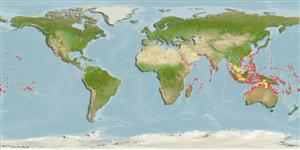Preferred temperature (Ref.
123201): 25 - 29.3, mean 28.3 °C (based on 2873 cells).
Phylogenetic diversity index (Ref.
82804): PD
50 = 0.5000 [Uniqueness, from 0.5 = low to 2.0 = high].
Bayesian length-weight: a=0.00955 (0.00430 - 0.02123), b=3.06 (2.89 - 3.23), in cm total length, based on LWR estimates for this Genus-body shape (Ref.
93245).
Trophic level (Ref.
69278): 3.6 ±0.56 se; based on food items.
Widerstandsfähigkeit (Ref.
120179): hoch, Verdopplung der Population dauert weniger als 15 Monate. (Preliminary K or Fecundity.).
Fishing Vulnerability (Ref.
59153): Low vulnerability (10 of 100).
Nutrients (Ref.
124155): Calcium = 77.5 [46.8, 130.8] mg/100g; Iron = 0.69 [0.41, 1.26] mg/100g; Protein = 18.5 [15.7, 20.7] %; Omega3 = 0.161 [0.105, 0.250] g/100g; Selenium = 25 [15, 44] μg/100g; VitaminA = 140 [44, 517] μg/100g; Zinc = 1.59 [1.10, 2.46] mg/100g (wet weight);
